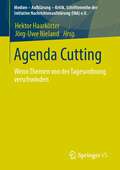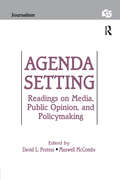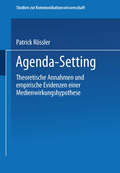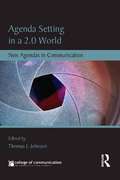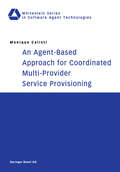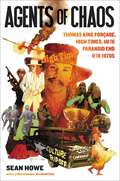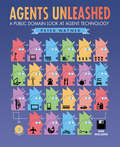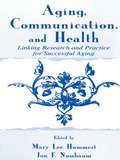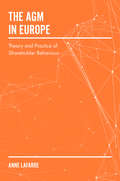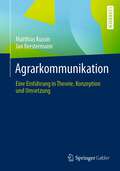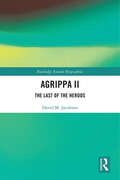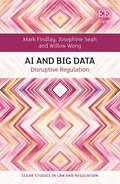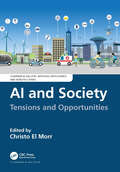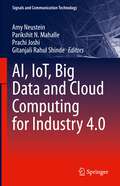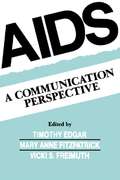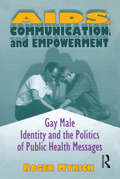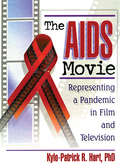- Table View
- List View
Agenda-Cutting: Wenn Themen von der Tagesordnung verschwinden (Medien – Aufklärung – Kritik. Schriftenreihe der Initiative Nachrichtenaufklärung (INA) e.V.)
by Hektor Haarkötter Jörg-Uwe NielandWenn von Nachrichtenauswahl und Thematisierungsfunktion der Medien die Rede ist, fällt schnell das Fachwort Agenda-Setting. Der gegenteilige Begriff, das Agenda-Cutting, ist dagegen viel seltener Gegenstand von wissenschaftlichen oder gesellschaftlichen Diskussionen. Dabei ist das Agenda-Cutting eine weitflächig geübte Praxis in Medien, Politik und Gesellschaft, bei der Themen bewusst oder unbewusst aus den gesellschaftlichen Diskursen entfernt oder herausgehalten werden. Die Initiative Nachrichtenaufklärung beschäftigt sich schon lange intensiv mit der Frage der Vernachlässigung von Themen und Nachrichten. Mit diesem Sammelband wird erstmals das Thema wissenschaftlich tiefgehend von verschiedenen Seiten aus betrachtet.
Agenda Setting: Readings on Media, Public Opinion, and Policymaking (Routledge Communication Series)
by David L. Protess Maxwell McCombsThe role of the news media in defining the important issues of the day, also known as the agenda-setting influence of mass communication, has received widespread attention over the past 20 years. Since the publication of McCombs and Shaw's seminal empirical study, more than one hundred journal articles and monographs have appeared. This collection exemplifies the major phases of research on agenda-setting: tests of the basic hypothesis, contingent conditions affecting the strength of this influence, the natural history of public issues, mass media influence on public policy, and the role of external sources from the president to public relations staffs on the news agenda.
Agenda Setting: Readings on Media, Public Opinion, and Policymaking (Routledge Communication Series)
by David Protess Maxwell E. McCombsThe role of the news media in defining the important issues of the day, also known as the agenda-setting influence of mass communication, has received widespread attention over the past 20 years. Since the publication of McCombs and Shaw's seminal empirical study, more than one hundred journal articles and monographs have appeared. This collection exemplifies the major phases of research on agenda-setting: tests of the basic hypothesis, contingent conditions affecting the strength of this influence, the natural history of public issues, mass media influence on public policy, and the role of external sources from the president to public relations staffs on the news agenda.
Agenda-Setting: Theoretische Annahmen und empirische Evidenzen einer Medienwirkungshypothese (Studien zur Kommunikationswissenschaft #27)
by Patrick RösslerDie Medien bestimmen die Themen der öffentlichen Tagesordnung - in der Kommunikationsforschung wird die Agenda-Setting-Hypothese oft als bewiesene Tatsache gehandelt. Eine kritische Durchsicht der über zweihundert empirischen Studien zeigt jedoch, daß die Aussagekraft vieler Arbeiten durch methodische Restriktionen eingeschränkt ist und die Gefahr des "ökologischen Fehlschlusses" birgt. Ein umfangreiches Forschungsprojekt vor dem Hintergrund der deutschen Wiedervereinigung weist unterschiedliche Thematisierungsmechanismen auf individueller und gesellschaftlicher Ebene nach.
Agenda Setting in a 2.0 World: New Agendas in Communication (New Agendas in Communication Series)
by Thomas J. JohnsonThis volume explores agenda-setting theory in light of changes in the media environment in the 21st century. In the decades since the original Chapel Hill study that launched agenda-setting research, the theory has attracted the interest of scholars worldwide. Agenda Setting in a 2.0 World features the work of a new generation of scholars. The research provided by these young scholars reflects two broad contemporary trends in agenda-setting: A centrifugal trend of research in the expanding media landscape and in domains beyond the original focus on public affairs, and a centripetal trend further explicating agenda-setting’s core concepts.
Agenda Setting in a 2.0 World: New Agendas in Communication (New Agendas in Communication Series)
by Thomas J. JohnsonThis volume explores agenda-setting theory in light of changes in the media environment in the 21st century. In the decades since the original Chapel Hill study that launched agenda-setting research, the theory has attracted the interest of scholars worldwide. Agenda Setting in a 2.0 World features the work of a new generation of scholars. The research provided by these young scholars reflects two broad contemporary trends in agenda-setting: A centrifugal trend of research in the expanding media landscape and in domains beyond the original focus on public affairs, and a centripetal trend further explicating agenda-setting’s core concepts.
An Agent-Based Approach for Coordinated Multi-Provider Service Provisioning (Whitestein Series in Software Agent Technologies and Autonomic Computing)
by Monique CalistiThis book proposes a novel approach to improve multi-provider interactions based on the coordination of autonomous and self-motivated software entities acting on behalf of distinct operators. In addition, a novel way of addressing resource allocation and pricing in a compact framework is made possible by the use of powerful resource abstraction techniques. The book is addressed to researchers in the area of agent technology, automated negotiation, distributed constraint satisfaction, and networking. Furthermore, it should be a valuable resource for both network and service providers
Agents of Chaos: Thomas King Forçade, High Times, and the Paranoid End of the 1970s
by Sean HoweThe life and times of High Times&’ enigmatic founder Thomas King Forçade, an underground newspaper editor and marijuana kingpin who—between police raids, smuggling runs, and outrageous stunts—battled both the US government and fellow radicals.Cover illustration by legendary comics artist Bill Sienkiewicz. At the end of the 1960s, the mysterious Tom Forçade suddenly appeared, insinuating himself into the top echelons of countercultural politics and assuming control of the Underground Press Syndicate, a coalition of newspapers across the country. Weathering government surveillance and harassment, he embarked on a landmark court battle to obtain White House press credentials. But his audacious exploits—pieing Congressional panelists, stealing presidential portraits, and picking fights with other activists—led to accusations that he was an agent provocateur. As the era of protest faded and the dark shadows of Watergate spread, Forçade hoped that marijuana could be the path to cultural and economic revolution. Bankrolled by drug-dealing profits, High Times would be the Playboy of pot, dragging a once-taboo subject into the mainstream. The magazine was a travelogue of globe-trotting adventure, a wellspring of news about &“the business,&” and an overnight success. But High Times soon threatened to become nothing more than the &“hip capitalism&” Forçade had railed against for so long, and he felt his enemies closing in. Assembled from exclusive interviews, archived correspondences, and declassified documents, Agents of Chaos is a tale of attacks on journalism, disinformation campaigns, governmental secrecy, corporatism, and political factionalism. Its triumphs and tragedies mirror the cultural transformations of 1970s America, wrought by forces that continue to clash in the spaces between activism and power.
Agents Unleashed: A Public Domain Look at Agent Technology
by Peter WaynerAgents Unleashed: A Public Domain Look at Agent Technology covers details of building a secure agent realm. The book discusses the technology for creating seamlessly integrated networks that allow programs to move from machine to machine without leaving a trail of havoc; as well as the technical details of how an agent will move through the network, prove its identity, and execute its code without endangering the host. The text also describes the organization of the host's work processing an agent; error messages, bad agent expulsion, and errors in XLISP-agents; and the simulators of errors, functions, and resources. Agent language, XLISP, TCL and other languages are also considered. The book further tackles security and encryption; commercial cash; and some ambitious and extreme examples of how people are attempting to create agents. The text also encompasses the instructions on how to use the XLISP agents. Software agents will find the book invaluable.
Aging, Communication, and Health: Linking Research and Practice for Successful Aging (Routledge Communication Series)
by Mary Lee Hummert Jon F. NussbaumThis collection highlights the current efforts by scholars and researchers to understand the aging process as it relates to the health of older adults. With contributions from international scholars in communication, psychology, public health, medicine, nursing, and other areas, this volume emphasizes communication as a critical research, education, policy, and practice issue for the design, provision, and evaluation of health and social services for older adults. Organized into sections addressing communication developments in the healthcare arena, issues in provider-patient communication, and the relationships between family communication and health. The chapters cover critical topics related to successful aging, such as Alzheimer's disease, managed care and older adults, communication issues of severe dementia, and healthcare decision-making within families. The editors have designed this volume to be accessible to a broad audience, including scholars and students of aging and communication, healthcare practitioners with older clients, and aging individuals and their families who are pursuing strategies for successful aging. The chapters represent the highest levels of current scholarship on communication, aging, and health, providing a strong foundation for future research. Each contribution also addresses the applied implications of this research, offering practical guidance to readers dealing with these issues in their own lives. As a whole, Aging, Communication, and Health represents a major advance toward understanding the importance and application of communication for successful aging.
Aging, Communication, and Health: Linking Research and Practice for Successful Aging (Routledge Communication Series)
by Mary Lee Hummert Jon F. NussbaumThis collection highlights the current efforts by scholars and researchers to understand the aging process as it relates to the health of older adults. With contributions from international scholars in communication, psychology, public health, medicine, nursing, and other areas, this volume emphasizes communication as a critical research, education, policy, and practice issue for the design, provision, and evaluation of health and social services for older adults. Organized into sections addressing communication developments in the healthcare arena, issues in provider-patient communication, and the relationships between family communication and health. The chapters cover critical topics related to successful aging, such as Alzheimer's disease, managed care and older adults, communication issues of severe dementia, and healthcare decision-making within families. The editors have designed this volume to be accessible to a broad audience, including scholars and students of aging and communication, healthcare practitioners with older clients, and aging individuals and their families who are pursuing strategies for successful aging. The chapters represent the highest levels of current scholarship on communication, aging, and health, providing a strong foundation for future research. Each contribution also addresses the applied implications of this research, offering practical guidance to readers dealing with these issues in their own lives. As a whole, Aging, Communication, and Health represents a major advance toward understanding the importance and application of communication for successful aging.
The AGM in Europe: Theory and Practice of Shareholder Behaviour
by Dr Anne LafarreBusiness, Economics and Legal scholars have all argued about the theoretical importance of annual general meetings in assessing business shareholder relations and wider issues of corporate governance, but often without knowing how the AGM functions in practice. Anne Lafarre combines wide ranging empirical legal and economic research to analyse and understand the real role of the AGM in the European businesses and corporate governance frameworks today. Focusing on seven European member states (Austria, Belgium, France, Germany, Ireland, the Netherlands and the UK) the author persuasively explores how the impact of legal rulings and business pressures effects shareholder representation in European AGMs and their propensity to affect change through these forums. Drawing wide ranging data sets to challenge existing economic and legal theory, the author presents practical conclusions and future policy implications.
The AGM in Europe: Theory and Practice of Shareholder Behaviour
by Dr Anne LafarreBusiness, Economics and Legal scholars have all argued about the theoretical importance of annual general meetings in assessing business shareholder relations and wider issues of corporate governance, but often without knowing how the AGM functions in practice. Anne Lafarre combines wide ranging empirical legal and economic research to analyse and understand the real role of the AGM in the European businesses and corporate governance frameworks today. Focusing on seven European member states (Austria, Belgium, France, Germany, Ireland, the Netherlands and the UK) the author persuasively explores how the impact of legal rulings and business pressures effects shareholder representation in European AGMs and their propensity to affect change through these forums. Drawing wide ranging data sets to challenge existing economic and legal theory, the author presents practical conclusions and future policy implications.
Agrarkommunikation: Eine Einführung in Theorie, Konzeption und Umsetzung
by Matthias Kussin Jan BerstermannTierwohl, Grüne Gentechnik, Hofsterben, biologische Vielfalt: Das Agri- und Foodbusiness steht im hohen Maße im Fokus der Öffentlichkeit. In diesem Buch werden Handlungsmöglichkeiten mit Blick auf die kommunikativen Aufgaben der Branche dargestellt – und dies erstmals auf Basis einschlägiger Ansätze aus den Kommunikationswissenschaften und dem PR-Management. Die Autoren liefern einen Überblick über branchenrelevante Themen wie Nachhaltigkeitskommunikation, Storytelling und Krisenkommunikation sowie ihre Einsatz- und Wirkungsweise im Rahmen einer professionellen Öffentlichkeitsarbeit.
Agrippa II: The Last of the Herods (Routledge Ancient Biographies)
by David JacobsonAgrippa II is the first comprehensive biography of the last descendant of Herod the Great to rule as a client king of Rome. Agrippa was the last king to assume responsibility for the management of the Temple in Jerusalem, and he ultimately saw its destruction in the Judaean-Roman War. This study documents his life from a childhood spent at the Imperial court in Rome and rise to the position of client king of Rome under Claudius and Nero. It examines his role in the War during which he sided with Rome, and offers fresh insights into his failure to intervene to prevent the destruction of Jerusalem and its Sanctuary, as well as reviewing Agrippa’s encounter with nascent Christianity through his famous interview with the Apostle Paul. Also addressed is the vexed question of the obscurity into which Agrippa II has fallen, in sharp contrast with his sister Berenice, whose intimate relationship with Titus, the heir to the Roman throne, has fired the imagination of writers through the ages. This study also includes appendices surveying the coins issued in the name of Agrippa II and the inscriptions from his reign. This volume will appeal to anyone studying Judaean-Roman relations and the Judaean-Roman War, as well as those working more broadly on Roman client kingship, and Rome’s eastern provinces. It covers topics that continue to attract general interest as well as stirring current scholarly debate.
Agrippa II: The Last of the Herods (Routledge Ancient Biographies)
by David JacobsonAgrippa II is the first comprehensive biography of the last descendant of Herod the Great to rule as a client king of Rome. Agrippa was the last king to assume responsibility for the management of the Temple in Jerusalem, and he ultimately saw its destruction in the Judaean-Roman War. This study documents his life from a childhood spent at the Imperial court in Rome and rise to the position of client king of Rome under Claudius and Nero. It examines his role in the War during which he sided with Rome, and offers fresh insights into his failure to intervene to prevent the destruction of Jerusalem and its Sanctuary, as well as reviewing Agrippa’s encounter with nascent Christianity through his famous interview with the Apostle Paul. Also addressed is the vexed question of the obscurity into which Agrippa II has fallen, in sharp contrast with his sister Berenice, whose intimate relationship with Titus, the heir to the Roman throne, has fired the imagination of writers through the ages. This study also includes appendices surveying the coins issued in the name of Agrippa II and the inscriptions from his reign. This volume will appeal to anyone studying Judaean-Roman relations and the Judaean-Roman War, as well as those working more broadly on Roman client kingship, and Rome’s eastern provinces. It covers topics that continue to attract general interest as well as stirring current scholarly debate.
AI and Big Data: Disruptive Regulation (Elgar Studies in Law and Regulation)
by Mark Findlay Josephine Seah Willow WongThis provocative and timely book identifies and disrupts the conventional regulation and governance discourses concerning AI and big data. It suggests that, instead of being used as tools for exclusionist commercial markets, AI and big data can be employed in governing digital transformation for social good. Analysing the ways in which global technology companies have colonised data access, the book reveals how trust, ethics, and digital self-determination can be reconsidered and engaged to promote the interests of marginalised stakeholders in data arrangement. Chapters examine the regulation of labour engagement in digital economies, the landscape of AI ethics, and a multitude of questions regarding participation, costs, and sustainability. Presenting several informative case studies, the book challenges some of the accepted qualifiers of frontier tech and data use and proposes innovative ways of actioning the more conventional regulatory components of big data. Scholars and students in information and media law, regulation and governance, and law and politics will find this book to be critical reading. It will also be of interest to policymakers and the AI and data science community.
AI and Society: Tensions and Opportunities (Chapman & Hall/CRC Artificial Intelligence and Robotics Series)
by Christo El MorrAI's impact on human societies is and will be drastic in so many ways. AI is being adopted and implemented around the world, and government and universities are investing in AI studies, research, and development. However, very little research exists about the impact of AI on our lives. This book will address this gap; it will gather reflections from around the world to assess the impact of AI on different aspects of society as well as propose ways in which we can address this impact and the research agendas needed.
AI and Society: Tensions and Opportunities (Chapman & Hall/CRC Artificial Intelligence and Robotics Series)
by Christo El MorrAI's impact on human societies is and will be drastic in so many ways. AI is being adopted and implemented around the world, and government and universities are investing in AI studies, research, and development. However, very little research exists about the impact of AI on our lives. This book will address this gap; it will gather reflections from around the world to assess the impact of AI on different aspects of society as well as propose ways in which we can address this impact and the research agendas needed.
AI, IoT, Big Data and Cloud Computing for Industry 4.0 (Signals and Communication Technology)
by Amy Neustein Parikshit N. Mahalle Prachi Joshi Gitanjali Rahul ShindeThis book presents some of the most advanced leading-edge technology for the fourth Industrial Revolution -- known as “Industry 4.0.” The book provides a comprehensive understanding of the interconnections of AI, IoT, big data and cloud computing as integral to the technologies that revolutionize the way companies produce and distribute products and the way local governments deliver their services. The book emphasizes that at every phase of the supply chain, manufactures are found to be interweaving AI, robotics, IoT, big data/machine learning, and cloud computing into their production facilities and throughout their distribution networks. Equally important, the authors show how their research can be applied to computer vision, cyber security, database and compiler theory, natural language processing, healthcare, education and agriculture.Presents the fundamentals of AI, IoT, and cloud computing and how they can be incorporated in Industry 4.0 applicationsMotivates readers to address challenges in the areas of speech communication and signal processingProvides numerous examples, case studies, technical descriptions, and approaches of AI/ML
Aids: A Communication Perspective (Routledge Communication Series)
by Timothy Edgar Mary Anne Fitzpatrick Vicki S. FreimuthPrevention through appropriate behavior is the best weapon available to fight further spread of HIV infection. However, individuals take necessary actions to prevent diseases such as AIDS only when they are properly informed and they feel motivated to respond to the information they possess. In order to achieve a clearer understanding of these two facets of the prevention process, this book examines the interplay of the messages individuals receive about AIDS at the public level and the messages exchanged between individuals at the interpersonal level. The specific purpose of the book is to provide a theoretical and conceptual foundation for understanding the pragmatic concerns related to the AIDS crisis in the United States and other parts of the world. The book represents the first systematic examination of how theory informs our understanding of AIDS and communication processes. Contributors explore the issues from a variety of theoretical and conceptual viewpoints. Their goal is to stimulate thought which will lead to the pragmatic application of the ideas presented. The chapters focus on four general communication concerns: * interpersonal interaction as it relates to choices individuals make about safer sex practices, * theory and practice of public campaigns about AIDS, * intercultural issues, and * critical and descriptive approaches for understanding news coverage of AIDS.
Aids: A Communication Perspective (Routledge Communication Series)
by Timothy Edgar Mary Anne Fitzpatrick Vicki S. FreimuthPrevention through appropriate behavior is the best weapon available to fight further spread of HIV infection. However, individuals take necessary actions to prevent diseases such as AIDS only when they are properly informed and they feel motivated to respond to the information they possess. In order to achieve a clearer understanding of these two facets of the prevention process, this book examines the interplay of the messages individuals receive about AIDS at the public level and the messages exchanged between individuals at the interpersonal level. The specific purpose of the book is to provide a theoretical and conceptual foundation for understanding the pragmatic concerns related to the AIDS crisis in the United States and other parts of the world. The book represents the first systematic examination of how theory informs our understanding of AIDS and communication processes. Contributors explore the issues from a variety of theoretical and conceptual viewpoints. Their goal is to stimulate thought which will lead to the pragmatic application of the ideas presented. The chapters focus on four general communication concerns: * interpersonal interaction as it relates to choices individuals make about safer sex practices, * theory and practice of public campaigns about AIDS, * intercultural issues, and * critical and descriptive approaches for understanding news coverage of AIDS.
AIDS, Communication, and Empowerment: Gay Male Identity and the Politics of Public Health Messages
by Roger MyrickAIDS, Communication, and Empowerment examines the cultural construction of gay men in light of discourse used in the media’s messages about HIV/AIDS--messages often represented as educational, scientific, and informational but which are, in fact, politically charged. The book offers a compelling and substantive look at the social consequences of communication about HIV/AIDS and the reasons for the successes and failures of contemporary health communication. This analysis is important because it provides a reading of health communication from a marginal perspective, one that has often been kept silent in mainstream academic research. AIDS, Communication, and Empowerment offers a critical, historical analysis of public health communication about HIV/AIDS; the ways this communication makes sense historically and culturally; and the implications such messages have for the marginal group which has been most stigmatized as a consequence of these messages. It covers such topics as: the relationship among gay identity, language, and power cultural studies of the historical development of gay identity studies in health communication about HIV/AIDS and health risk communication the political consequences of public health education about HIV/AIDS on gay men the political consequences of media representations of gay identity and its relationship to disease Based primarily on the French scholar Michel Foucault’s critical, historical analysis of discourse and sexuality, this book takes a timely and original approach which differs from traditional, quantitative communication studies. It examines the relationship between language and culture using a qualitative, cultural studies approach which places medicalization theories in the broader context of histories of sexuality, the discursive development of contemporary gay identity, and recent public health communication.Author Roger Myrick explains how mainstream communication about HIV/AIDS relentlessly stigmatizes and further marginalizes gay identity. He describes how national health education stigmatizes groups by associating them with images of disease and “otherness.” Even communication which originates from marginal groups, particularly those relying on federal funds, often participates in linking gay identities with disease. According to Myrick, government funding, while often necessary for the continuation of community-based health campaigns, poses obvious and direct restrictions on effective marginal education. AIDS, Communication, and Empowerment allows for a rethinking of ways marginal groups can take control of their own education on public health issues. As HIV/AIDS cases continue to rise dramatically among marginalized and disenfranchised groups, analysis of health communication directed toward them becomes crucial to their survival. This book provides valuable insights and information for scholars, professionals, readers interested in the relationship among language, power and marginal identity, and for classes in gay and lesbian studies, health communication, or political communication.
AIDS, Communication, and Empowerment: Gay Male Identity and the Politics of Public Health Messages
by Roger MyrickAIDS, Communication, and Empowerment examines the cultural construction of gay men in light of discourse used in the media’s messages about HIV/AIDS--messages often represented as educational, scientific, and informational but which are, in fact, politically charged. The book offers a compelling and substantive look at the social consequences of communication about HIV/AIDS and the reasons for the successes and failures of contemporary health communication. This analysis is important because it provides a reading of health communication from a marginal perspective, one that has often been kept silent in mainstream academic research. AIDS, Communication, and Empowerment offers a critical, historical analysis of public health communication about HIV/AIDS; the ways this communication makes sense historically and culturally; and the implications such messages have for the marginal group which has been most stigmatized as a consequence of these messages. It covers such topics as: the relationship among gay identity, language, and power cultural studies of the historical development of gay identity studies in health communication about HIV/AIDS and health risk communication the political consequences of public health education about HIV/AIDS on gay men the political consequences of media representations of gay identity and its relationship to disease Based primarily on the French scholar Michel Foucault’s critical, historical analysis of discourse and sexuality, this book takes a timely and original approach which differs from traditional, quantitative communication studies. It examines the relationship between language and culture using a qualitative, cultural studies approach which places medicalization theories in the broader context of histories of sexuality, the discursive development of contemporary gay identity, and recent public health communication.Author Roger Myrick explains how mainstream communication about HIV/AIDS relentlessly stigmatizes and further marginalizes gay identity. He describes how national health education stigmatizes groups by associating them with images of disease and “otherness.” Even communication which originates from marginal groups, particularly those relying on federal funds, often participates in linking gay identities with disease. According to Myrick, government funding, while often necessary for the continuation of community-based health campaigns, poses obvious and direct restrictions on effective marginal education. AIDS, Communication, and Empowerment allows for a rethinking of ways marginal groups can take control of their own education on public health issues. As HIV/AIDS cases continue to rise dramatically among marginalized and disenfranchised groups, analysis of health communication directed toward them becomes crucial to their survival. This book provides valuable insights and information for scholars, professionals, readers interested in the relationship among language, power and marginal identity, and for classes in gay and lesbian studies, health communication, or political communication.
The AIDS Movie: Representing a Pandemic in Film and Television
by Kylo-Patrick R HartAre people with HIV/AIDS treated fairly in films?Here is a compelling book that provides you with a thorough examination of how HIV/AIDS is characterized and portrayed in film and how this portrayal affects American culture. The AIDS Movie: Representing a Pandemic in Film and Television uncovers the primary ways that films about HIV/AIDS influence American ideology and contribute to society's view of the disease. In The AIDS Movie, professors and scholars in the areas of popular culture, film, sociology, and gay and lesbian studies will discover cross-cultural approaches that can be used to analyze the representation of AIDS in American films made in the first two decades of the pandemic. Giving you insight into the production and circulation of social meanings pertaining to HIV/AIDS, this study explores the social ramifications of such representations for gay men in American society, as well as for the rest of the population. Interesting and informative, The AIDS Movie: Representing a Pandemic in Film and Television examines the ways that AIDS has been represented in American movies over the past two decades, defines and proposes criteria for identifying an “AIDS movie” and explores how these images shape social opinions about AIDS and gay men. The AIDS Movie discusses several character types such as “innocent victims” and “guilty villains” and the process of victim-blaming that occurs in AIDS movies. Defining an “AIDS movie” as a film with at least one character who either has been infected with HIV, has developed AIDS, or is grieving the recent death of a loved one from AIDS, this guide bases standards for these movies on several works, including: Chocolate Babies It's My Party Jeffrey The Living End Grief An Early Frost Men in Love A Place for Annie Philadelphia The Ryan White Story Gia Boys on the SideThe AIDS Movie: Representing a Pandemic in Film and Television is compelling and insightful as it cleverly reveals how AIDS is portrayed in cinema and television, and how that portrayal affects American culture.
